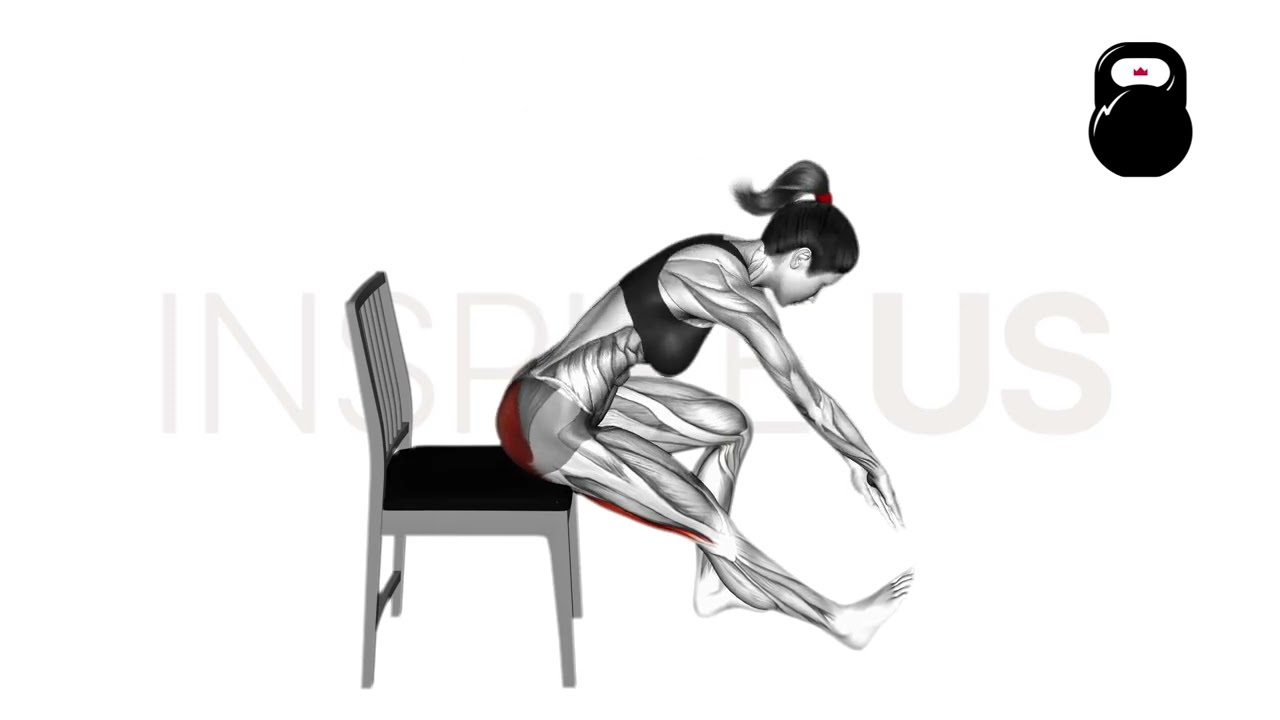Seated Hamstring Stretch: Benefits, Muscles Targeted, and More
Poor posterior chain flexibility is a common complaint among sedentary individuals. However, even among the highly active, tight and sore hamstrings are also frequently encountered.
Fortunately, stretching out the hamstrings can be as easy as sitting in a chair and performing the seated hamstring stretch.
As the name implies, the seated hamstring stretch is a static hamstring stretch performed while in a seated position. It is accessible to all types of healthy individuals, and can be safely performed despite no experience with stretching exercises whatsoever.
What is the Seated Hamstring Stretch?
In technical examination, the seated hamstring stretch is a unilateral static stretch primarily involving knee extension to lengthen the hamstring muscles along the back of the thigh.
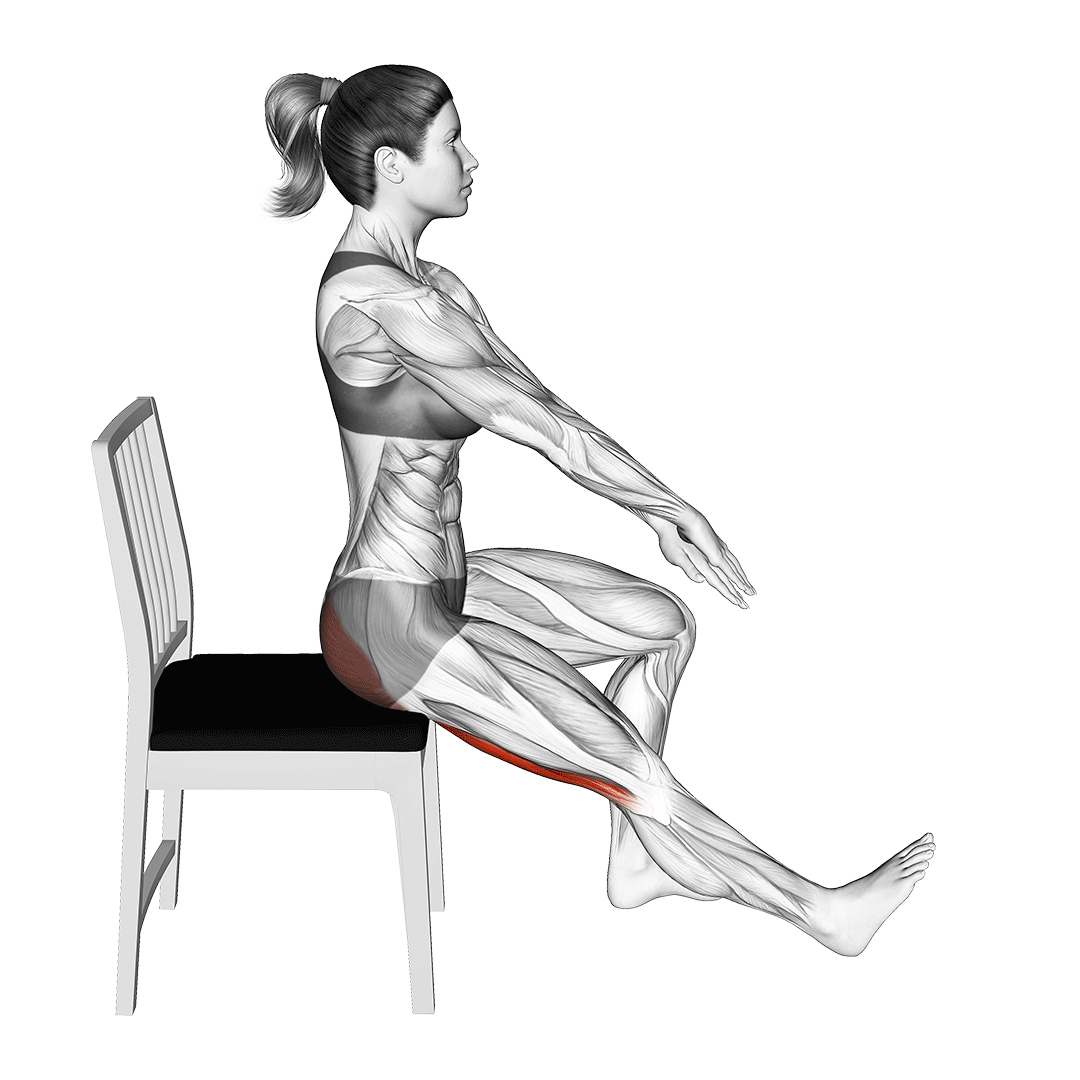
Seated hamstring stretches see performance in a variety of environments, be it athletic, clinical or by individuals at home. Its wide usage is primarily due to the simplicity with which it can be performed. So long as the performer can safely extend their knee and stretch their hamstrings without injury, they can do the seated hamstring.
Note that the seated hamstring stretch is distinct from the stretch of the same name that seats the exerciser on the floor. This article is specifically about the hamstring stretch involving the exerciser seated atop a chair.
How to Do the Seated Hamstring Stretch
To perform the seated hamstring stretch, the exerciser will seat themselves atop a chair with the base of the buttocks near the edge. Both feet should begin flat on the floor before them.
From this position, the exerciser then extends one leg forwards, lifting the foot off the ground until only the heel is resting on the floor. A stretching sensation should be felt along the back of the thigh.
If no sensation is felt, the exerciser may bend forwards at the waist, being careful to keep their glutes stationary atop the chair and the working leg fully extended. The spine should remain in a neutral curvature as well.
Hold for up to 30 seconds before switching to the opposite leg.
Muscles and Joints Targeted by the Seated Hamstring Stretch
The seated hamstring stretch targets all the muscles that make up the hamstring muscle group. This means both heads of the biceps femoris, the semimembranosus and the semitendinosus.
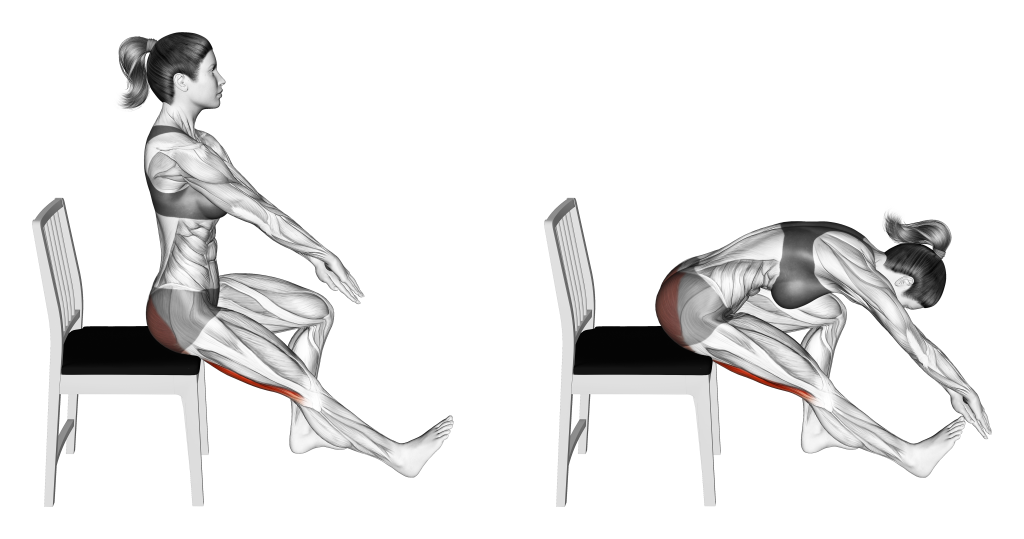
These three muscles affix to the base of the pelvis, fibula and tibia bones while the biceps femoris also attaches to the femur as well. In short, apart from the hamstring muscles themselves, the relevant tendons that attach to these bones are also stretched by the exercise.
What are the Benefits of Doing the Seated Hamstring Stretch?
The seated hamstring stretch is used so widely due to the variety of benefits it offers.
Be it for an athlete’s cool-off routine, recovering a previously injured hamstring’s flexibility or helping alleviate lower back pain, the seated hamstring is used.
Improved Hamstring Function, Flexibility and Stability
Clearly, the main benefit to doing seated hamstring stretches is its capacity to improve hamstring function. This is in terms of both passive stretching capacity and the hamstrings ability to actively contract within a range of movement.
Sedentary individuals, those who regularly wear high heels and lifters who excessively perform posterior chain exercises can all cause the hamstrings to be chronically contracted.
This leads to not only poor flexibility, but also a lack of stability outside of their usual length. The seated hamstring is one method of alleviating these issues.
Reinforces Knee Flexion and Hip Extension
The hamstrings - alongside the glutes - are responsible for the kinematic functions of knee flexion and hip extension.
When the hamstrings suffer from poor flexibility, these functions shorten in terms of range of movement - leading to individuals who cannot fully bend their calf behind their thigh, or have difficulty pushing the hips out.
When combined with movements like the standing adductor stretch and various glute stretches, the seated hamstring stretch allows the performer to fully recover their lower body mobility.
Helps Reduce Lower Back Pain, Prevent Future Injury Risk and Maintain Proper Posture
Inflexible or unstable hamstrings can easily lead to poor posture and disadvantageous alignment of the pelvis. In turn, this draws the lower back into a similarly poor position, leading to lower back pain, an increased risk of spinal injuries and generally bad posture throughout the body.
Including the seated hamstring stretch into a rehabilitative, prehabilitative or corrective routine will help alleviate all these risks - as well as reduce any risk of such issues occurring in the future.
Simple, Zero-Impact and No Risk of Injury
The seated hamstring stretch is as simple a movement as they come. So long as there is no risk of tearing of the hamstrings or their subsequent tendons, then the exercise should be safe to perform.
Even for individuals with severely hampered hamstring flexibility, the exercise can be made compatible by simply extending the leg to a lesser degree. Over time, the exerciser should gradually increase the length in which the hamstrings are stretched by extending the leg further.
Common Seated Hamstring Stretch Mistakes
Although the seated hamstring stretch is quite safe, avoid the following mistakes in order to get the most out of its benefits.
Raising the Heel Off the Floor
Without the support of the heel on the ground, the seated hamstring stretch will contract the quadriceps muscles and create more pressure than is necessarily required.
Because the seated hamstring stretch is meant to be low-impact and static, ensure that at least part of the heel remains touching the floor throughout the exercise.
Bending the Knee
Bending the knee will reduce the length to which the hamstrings are stretched, as the hamstrings attach to the back of the knee joint and the nearby bones that make up the shin. The closer these structures are to the pelvis, the shorter the hamstrings will be.
While it is indeed possible to stretch the hamstrings with the knees bent (i.e. runners stretch) - for the purposes of the seated hamstring stretch, try to keep the knees as straight as mobility allows.
Using a Chair That is Too Short
Selecting a chair or bench too close to the floor can make the seated hamstring stretch more difficult than needed.
Individuals with particularly poor hamstring flexibility should select a chair 1-2 feet off the ground so as to ease into improving their hamstring flexibility.
The more horizontal the upper leg’s position as the stretch is being performed, the greater the hamstrings will be lengthened.
Alternatives to the Seated Hamstring Stretch
If the seated hamstring stretch isn’t quite to your liking - don’t worry. Try the following alternatives out instead.
Lying Hamstring Stretch
The lying hamstring stretch requires the exerciser to lie atop their back and extend one leg vertically upwards, using their arms to draw the thigh further back.
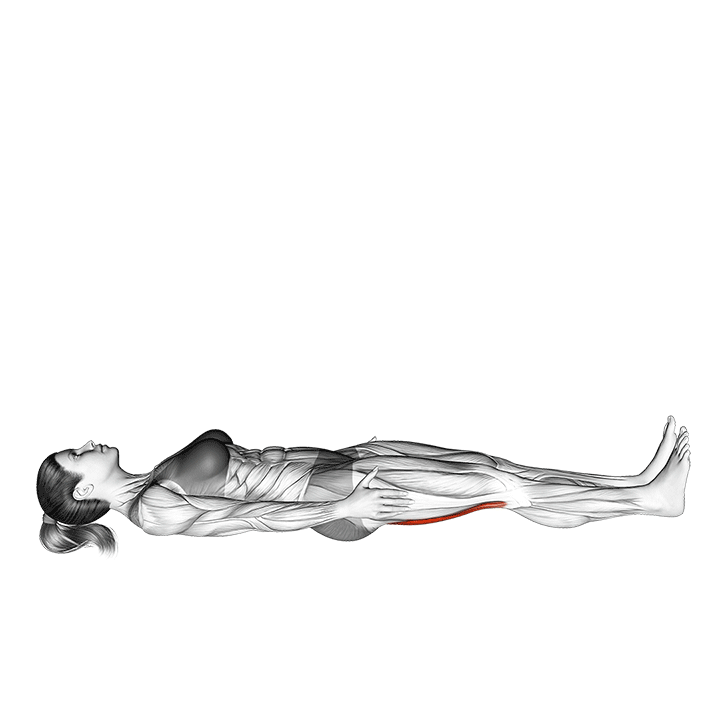
In comparison to its seated cousin, the lying hamstring stretch allows for a greater range of movement to be fulfilled - as well as a more active stretching stimulus due to the involvement of the hands.
Use the lying hamstring stretch once the seated variation is no longer challenging.
Standing Hamstring Stretch
The standing hamstring stretch is mechanically similar to the seated hamstring stretch. Only, rather than being seated, the exerciser is standing and elevates their heel atop a low platform instead.
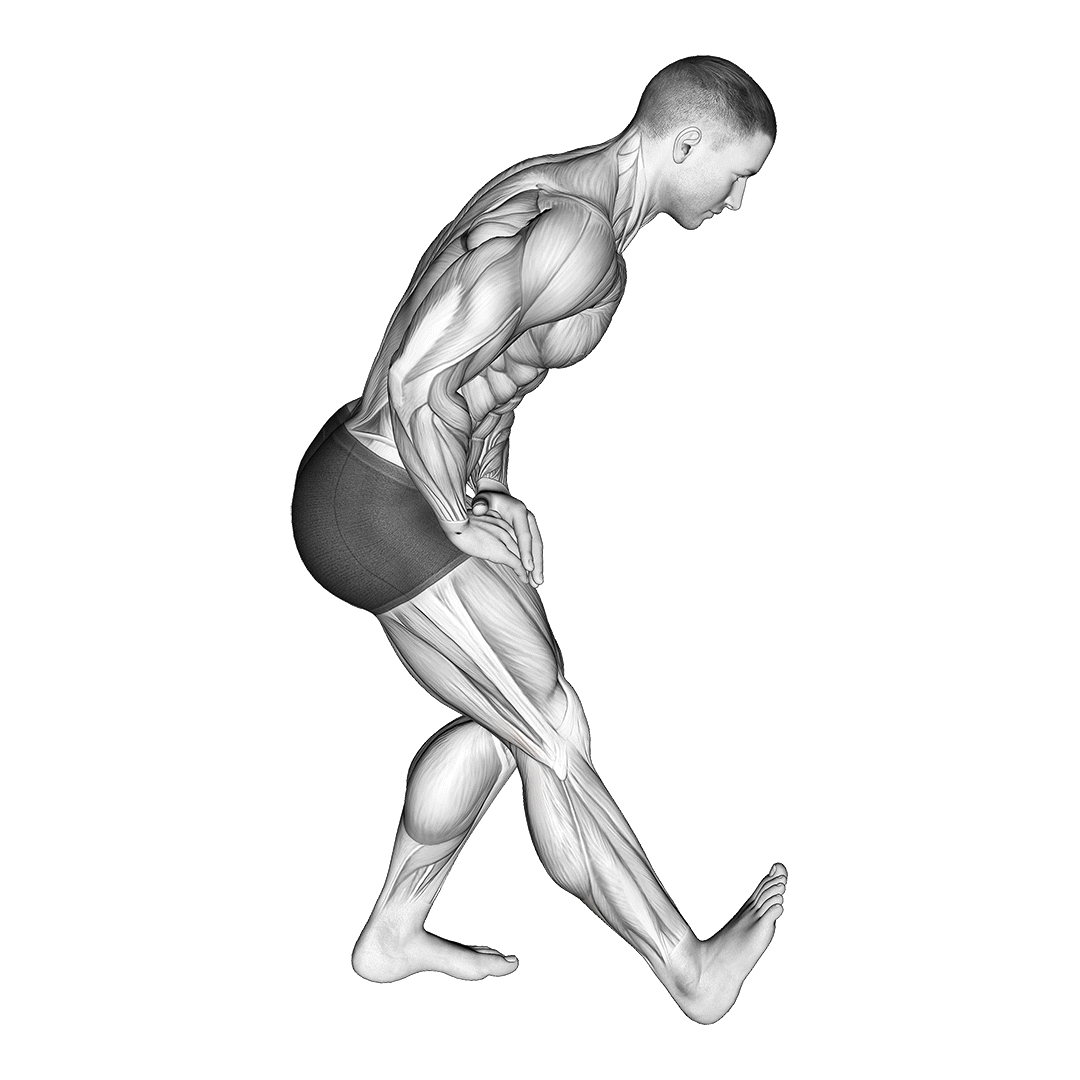
This particular alternative is best for exercisers that find the seated variation inconvenient, such as runners or individuals without access to a suitably low chair.
Hurdler Hamstring Stretch
The hurdler hamstring stretch has the exerciser sitting on the floor with one leg extended straight forwards, the other bent inwards at the knee.
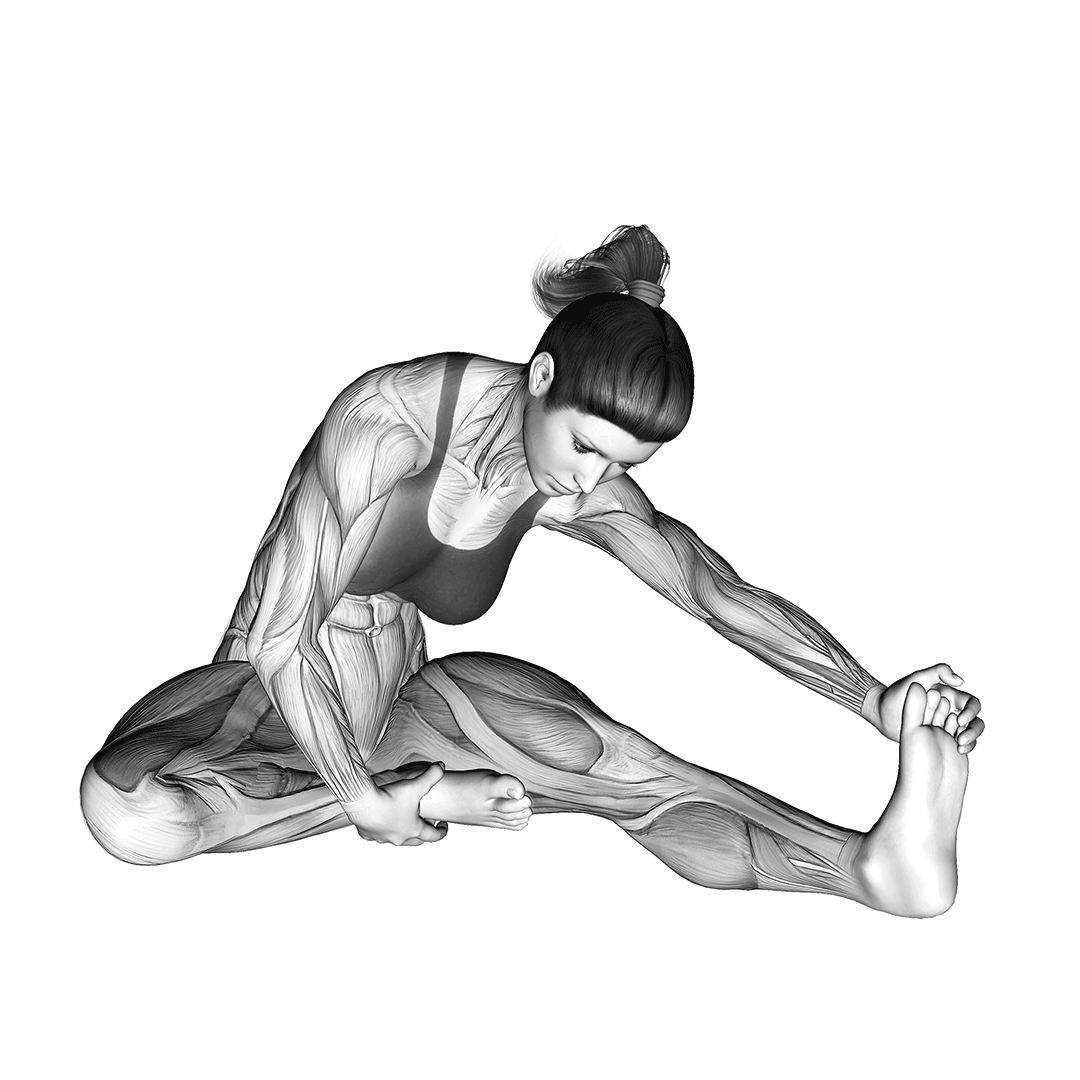
While in this stance, the hamstrings may be lengthened further by bending forwards at the waist - just as is the case with the seated hamstring stretch.
The hurdler hamstring stretch is best used as an alternative once the seated hamstring stretch is no longer as challenging.
Frequently Asked Questions (FAQ)
Is the Seated Hamstring Stretch a Static Stretch?
Yes. The seated hamstring stretch is meant to be held in place for an extended period, meaning that it is a static stretch.
Can the Elderly Do the Seated Hamstring Stretch?
Yes - so long as prior approval from their physician is given. Proper mobility work is especially important for the elderly, who experience marked loss in tissue integrity and flexibility.
How Do You Strengthen Your Hamstrings?
Strengthening the hamstrings requires more than simple static stretches. If you are healthy and able, try including resistance exercises like the lying leg curl, bodyweight squats and lunges as well.
In Conclusion
The seated hamstring stretch is excellent for improving hamstring flexibility, be it for a sedentary individual or an elite athlete.
If you have a history of shortened or injured hamstrings, remember to first consult a physician prior to attempting any movement involving the lower posterior chain. While the seated hamstring stretch is indeed safe, this is not always the case for individuals who are at greater risk of injury than the general population.
Remember to also perform stretches targeting the lower back and glutes for a more comprehensive mobility routine.
References
1. Medeiros, Diulian M et al. “Influence of static stretching on hamstring flexibility in healthy young adults: Systematic review and meta-analysis.” Physiotherapy theory and practice vol. 32,6 (2016): 438-445. doi:10.1080/09593985.2016.1204401
2. Jandre Reis, Felipe Jose, and Adriana Ribeiro Macedo. “Influence of Hamstring Tightness in Pelvic, Lumbar and Trunk Range of Motion in Low Back Pain and Asymptomatic Volunteers during Forward Bending.” Asian spine journal vol. 9,4 (2015): 535-40. doi:10.4184/asj.2015.9.4.535

